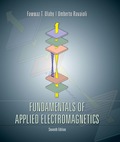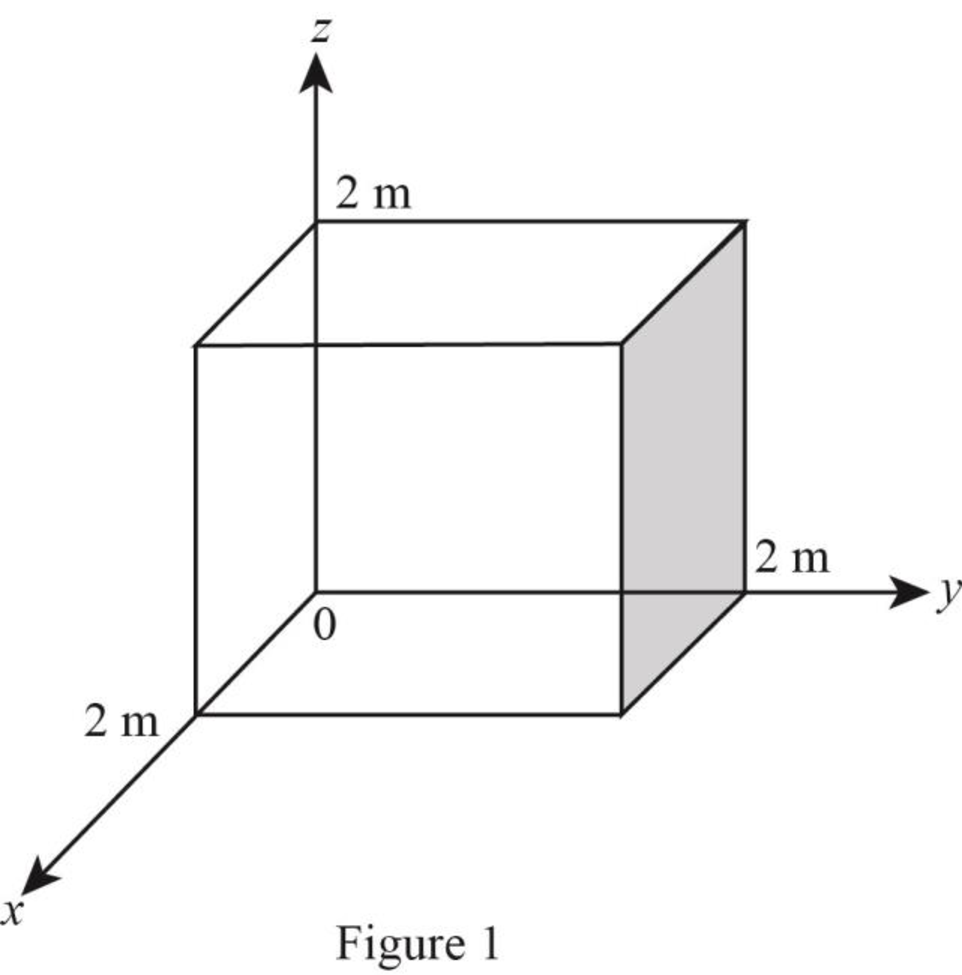
Concept explainers
A cube 2 m on a side is located in the first octant in a Cartesian coordinate system, with one of its corners at the origin. Find the total charge contained in the cube if the charge density is given by ρv = xy2e−2z (mC/m3).
The total charge contained in the cube for the given conditions.
Answer to Problem 1P
The total charge contained in the cube for the given conditions is
Explanation of Solution
Given data:
The side of the cube is
The volume charge density is
Calculation:
The required diagram for the given condition is drawn as shown in Figure 1.

Write the standard expression of charge for volume charge density.
Here,
Differential volume in Cartesian coordinate system is,
The given cube is resting on one of its corner at origin and in the first quadrant.
Hence, range of
Range of
Range of
Substituting
Solve the above expression.
Conclusion:
Therefore, the total charge contained in the cube is
Want to see more full solutions like this?
Chapter 4 Solutions
Fundamentals of Applied Electromagnetics (7th Edition)
- Write a Verilog program to design the 4-bit ripple carry counter using the instantiation process available in Verilog HDL and write the stimulus program to check the functionality of the design. Assume 4-bit ripple carry counter is designed from a T-flipflop and T-flipflop is designed from a D- flipflop.arrow_forwardHW3: A 9.375-GHz uniform plane wave is propagating in polyethylene (&-2.26). If the amplitude of the electric field intensity is 500 V/m and the material is assumed to be lossless, find: (a) the phase constant; (b) thearrow_forwardHW1: The location of the sliding bar in Figure below is given by x = 5t + 2t³, and the separation of the two rails is 20 cm. Let B = 0.8x2a, T. Find the voltmeter reading at (a) t = 0.4 s; (b) x = 0.6 m.arrow_forward
- For the circuit shown in Fig. 2.18, he =1.1 K2, hfe =50. Find Avf, Rif and Rof. { Ans: -3.2; 1935; X2807. Ans:-3-2;193;728. Vcc Rs=10kQ RF = 40kQ Re=4KQ -ov Vsarrow_forwardFor the system shown in figure below, the per unit values of different quantities are E-1.2, V 1, X X2-0.4. Xa-0.2 Determine whether the system is stable for a sustained fault. The fault is cleared at 8-60°. Is the system stable? If so find the maximum rotor swing. Find the critical clearing angle. E25 G X'd 08 CB X2 F CB V28 Infinite busarrow_forward17 For the circuit shown in Fig. 2.20, the transistors are identical and have the following parameters: hfe = 50, hie 1.1K, hre = 0, and hoe = 0. Calculate Auf, Rif and Rof. 25 V {Ans #45.4; 112 KM; 129 150k 47k www www +11 www 10k 6 4.7k 50μF Rif R₂1000 w 4.7k 47k Vo Q2 33k 4.7k ww 50µF 5μF 4.7k 1 R₁ Rofarrow_forward
- For the circuit shown in Fig. 2.18, he =1.1 K2, hfe =50. Find Avf, Rif and Rof. { Ans: -3.2; 1935; X2807. Ans:-3-2;193;728. Vcc Rs=10kQ RF = 40kQ Re=4KQ -ov Vs Fig. 2.18 Circuit for Q5.arrow_forwardThe circuit of Fig. 2.16 is to have Af=-1mA/V, D=1+ BA = 50, a voltage gain of -4, Rs =1KQ, and hfe = 150. Find RL, Re, Rif and Rof.. Vcc www RL OV Ans: 4 kor; 98053150 KS;∞. { An Re Fig. 2.16 Circuit for Q3.arrow_forwardDuring the lab you will design and measure a differential amplifier, made with an opamp. inside generator R5 ww 500 V1 0.1Vpk 1kHz 0° R6 w 50Ω R1 ww 10ΚΩ VCC C1 balanced wire R3 w 15.0V signal+ 100nF U1A TL082CP ground 2 signal- R4 w C2 Question5: Calculate R3 and R4 for a 20dB. 100nF VEE -15.0V R2 ww 10ΚΩarrow_forward
- not use ai pleasearrow_forward3. Consider the system described by the transfer function Gp(s) polynomial controller to satisfy the below specifications: 1) The settling time is t = 1 second, 2) 0.1% peak overshoot, 3) and zero steady-state error for a ramp input. The sampling period is T = 0.01 second. 1 = Design a discrete-time s(s+5)*arrow_forwardProblem 2 Does there exist a value a that makes the two systems S₁ and S₂ equal? If so, what is this value ? If not, explain why. S₁ x[n] x[n] D D -2 → host 回洄 S with h[m] " 999. усиз -1012345 harrow_forward
 Delmar's Standard Textbook Of ElectricityElectrical EngineeringISBN:9781337900348Author:Stephen L. HermanPublisher:Cengage Learning
Delmar's Standard Textbook Of ElectricityElectrical EngineeringISBN:9781337900348Author:Stephen L. HermanPublisher:Cengage Learning
